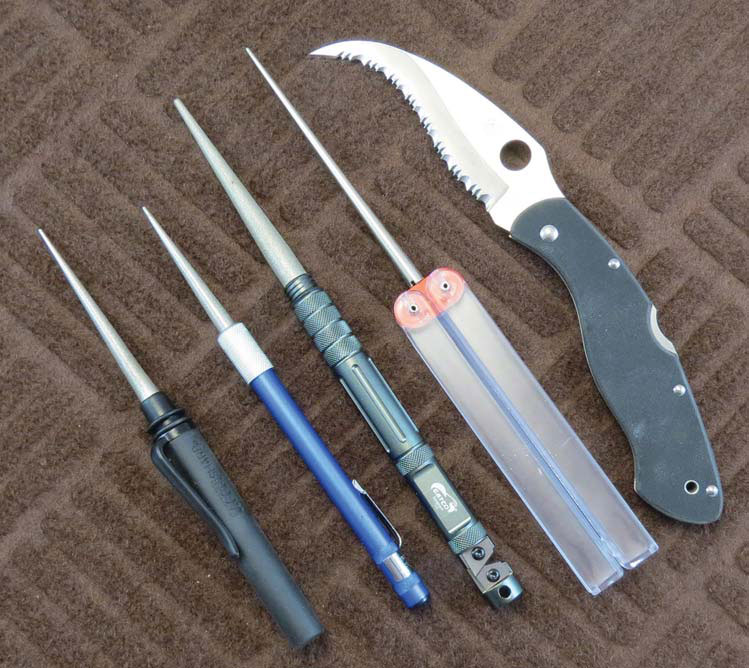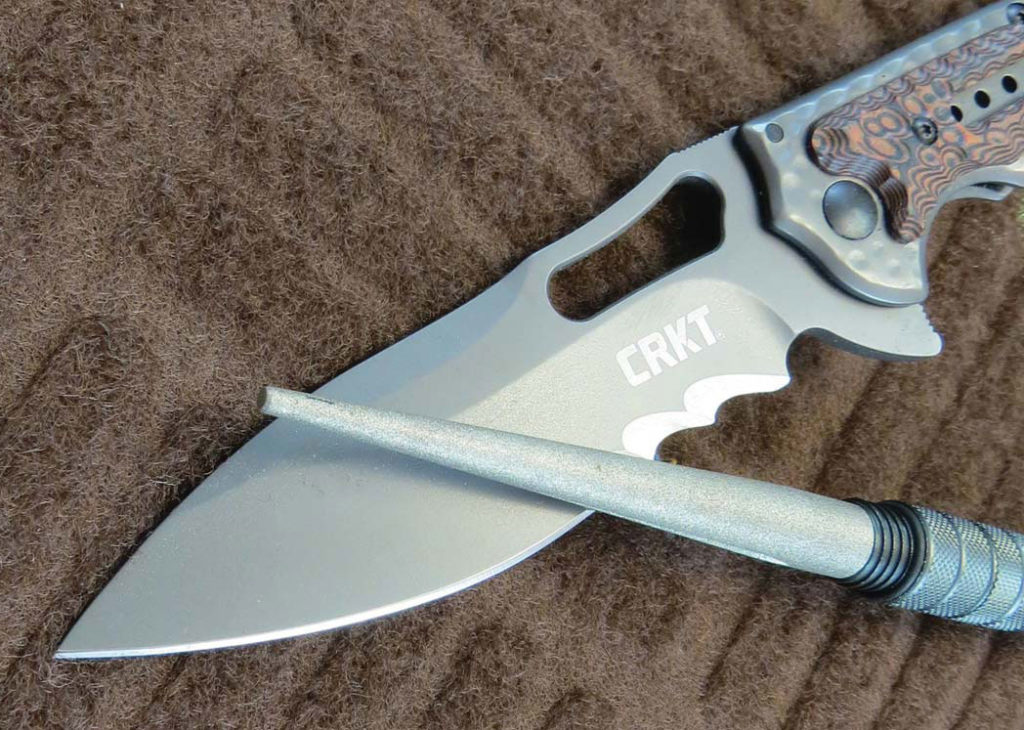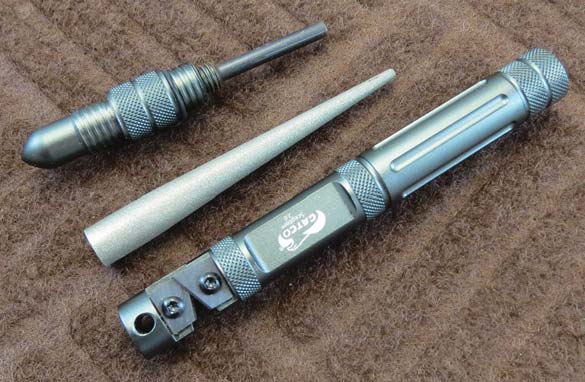

How to Sharpen a Serrated Knife: Quick Tips
- Use a small sharpening rod
- Lock the rod into a “gullet,” the groove of the serration
- Work the rod with slow, smooth motions away from the knife, applying light pressure
- Work the rod in one direction; don’t rub it back and forth
- Don’t sharpen wider than the serration
Sharpening Rods are Musts for Sharpening Serrated Knives
No matter what edge style of knife you carry, it must be sharpened. In the case of serrated blades, you need specialized tools, called sharpening rods.
Some rods, like the ones you’ll typically find in a kitchen, are large. Those won’t be helpful for working with small serrations. You need to find a small rod that will lock into place inside the serration. Don’t worry about sizing, though. Most small sharpening rods are tapered so that you’ll have the right fit no matter what.
Practice Makes Perfect
Learning how to sharpen serrated knives is like any other technique—you need practice to get good at it. I recommend buying some cheap knives and practicing before you move on to your $200 Spyderco. Also, remember that not all diamond sharpeners are created equal. Diamonds are manufactured and certain diamonds are more durable than others—then again, that’s a topic for a different time.
Know Your Geometry
There are a couple of key points about geometry for learning how to sharpen a knife with serrations.
As with a plain edge, you are polishing a surface. In the case of serrated blades, there are two geometries to work.
One is the gullet. The gullet is the internal section that normally has a curved shape between the points of a serrated edge. Since sharp gullets are necessary, many people mistakenly focus too much on the gullets and not enough on the teeth of the pattern. The teeth do the initial entry into the material and begin the cut.
Hence, when sharpening serrated blades you not only polish the gullet of the serration but also re-point the teeth at the same time. Much like sharpening a saw, you reform the teeth and restore the geometry of the teeth along with the geometry of the gullet.
Four Sharpeners for Sharpening Serrated Rods


Retractable Sharpener and Accusharp Diamond Compact Sharpener.
Here’s a good place to start. Our lineup of four sharpeners consists of the GATCO Scepter 2.0, Smith’s Diamond Retractable Sharpener, DMT Diafold serrated sharpener and Accusharp Diamond Compact Sharpener.
GATCO Scepter 2.0

right, a carbide sharpener, diamond cone and a ferrocerium rod all in one.
Of the four, the GATCO Scepter 2.0 is more multi-tool than sharpener only.
If you are into gadgets that serve more than one purpose, the Scepter 2.0 is for you. It has two tungsten-carbide blades for sharpening, a ferrocerium rod and a diamond cone sharpener. All are in a compact package that resembles a tactical pen. The diamond rod has a groove for sharpening fishhooks.
The cone has a medium-grade texture and a broad taper. The cone is 3.75 inches long and tapers from .113 to .392 of an inch in diameter. Why does the taper matter? If the taper is steep, during sharpening you will have a shorter cut as the cone will get too wide too quickly for some smaller serrations. Overall length: 6.125 inches.
If you’re looking for a sharpener as an everyday carry tool, the Scepter 2.0 is a good choice. The cone is a bit chunky but works fine for all but the smallest serrations. I am not a big fan of carbide sharpening blades because they hog off a lot of metal, though I don’t mind them on rough cutting tools. I haven’t had the Scepter long enough to testify to the durability of the diamond cone but so far it is holding up well.
Smith’s Diamond Retractable Sharpener

Smith’s Diamond Retractable Sharpener is the trimmest of the group and looks like a pen when collapsed. It is possible to use the cone shape to sharpen a plain edge, but with the Smith’s model the diamond coated sharpener has two ends.
One end has a flat section and the other is tapered for serrated edges. Of the group the Smith’s hone has the most aggressive grit. The body of the holder is aluminum and has a pen clip. (The GATCO Scepter could use a pen clip to complete it.) Closed length: 5.187 inches.
Again, I could see this tool in someone’s EDC kit, a tackle box or camping gear. At the tip the cone measures .06 inch and at the widest point .256 inch in diameter. With such a fine tip expanding in size over its 2.375-inch length, the Smith’s hone sharpens a wide range of serration styles. At a manufacturer’s suggested retail price of $7.99, it does not have to last a lifetime to pay for itself.
DMT Diafold

The DMT Diafold serrated sharpener comes in three color-coded grits: coarse (blue) 325 mesh or 45 micron, fine (red) 600 mesh or 25 micron, and X fine (green) 1200 mesh or 9 micron. I used the red.
Of the quartet it was the longest, finest-grit tapered cone. Overall length: 4.5 inches. It tapers in diameter from .62 inch at the tip to .25 inch at the base.
To store the sharpening cone DMT uses a folding handle system similar to a butterfly knife. The handle is a clear polycarbonate. At 5 inches closed and as with the others the Diafold is compact enough to be EDC’d.
I’ve had a number of DMT Diafolds over the years and they are still in working order. You have to use some of the diamond sharpeners a lot before they will wear out. I will say when open, the very appearance of the Diafold can send shivers down your spine as it resembles an icepick. It works well and if you like something with a fuller handle to it, a Diafold might be your shtick.
Accusharp Diamond Compact Sharpener

The Accusharp Diamond Compact Sharpener is 3.125 inches long with inch diameters of .06 at the tip and .305 at the base. A plastic body with a rubberized coating houses the unit—definitely low tech and follows the K.I.S.S. principle. A friction fit holds the sharpener open and closed. The fit is tight and you don’t have to worry about the two sides separating accidentally. An integral pen clip is on the main body’s housing. The clip doesn’t seem robust and I can see it eventually snapping off.
The sharpener has a medium-grit diamond coating and functioned well during testing. Accusharp includes a hook groove I find rather large. Maybe it’s for big fish. The closed length is the shortest of the group: 4.75 inches.
I like the design because as with the Smith’s sharpener it appears to be a standard pen as opposed to the GATCO model’s large-tactical-pen look. If you want to carry a sharpener and not let anyone know you have one so you aren’t constantly loaning it out, the Smith’s might be the ticket. As far as feel, the handle diameter is nice and comfortable.
 NEXT STEP: Download Your Free KNIFE GUIDE Issue of BLADE Magazine
NEXT STEP: Download Your Free KNIFE GUIDE Issue of BLADE Magazine
BLADE’s annual Knife Guide Issue features the newest knives and sharpeners, plus knife and axe reviews, knife sheaths, kit knives and a Knife Industry Directory.Get your FREE digital PDF instant download of the annual Knife Guide. No, really! We will email it to you right now when you subscribe to the BLADE email newsletter.







You are welcome. Let us know what kind of information you would like to read about.
Thank You
Blade Magazine…
Nice informative article. Thanks very much!